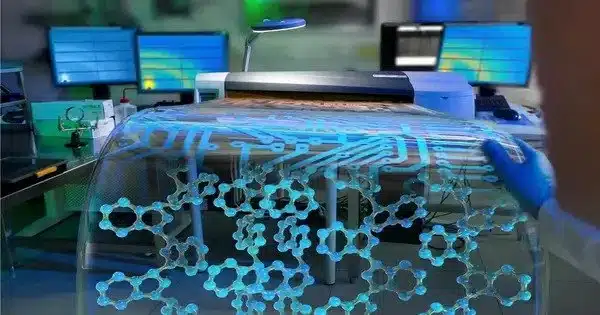Organic electronics is a material science subject that focuses on the design, synthesis, characterization, and use of organic molecules or polymers with desirable electrical properties such as conductivity. It is a field of electronics that uses organic materials, especially organic polymers, and tiny organic molecules, to construct electronic components and devices. It is also known as organic or polymer electronics.
Organic electronic materials, as opposed to typical inorganic conductors and semiconductors, are made from organic (carbon-based) molecules or polymers utilizing synthetic techniques discovered in the context of organic chemistry and polymer chemistry. Organic electronics, as opposed to typical silicon-based electronics, which rely on inorganic elements such as silicon, take advantage of organic materials that have unique qualities such as flexibility, cheap cost, and the capacity to be processed from solution.
Organic electronics’ projected cheap cost in comparison to standard electronics is one of the stated benefits. Polymeric conductors are appealing due to their electrical conductivity (which may be adjusted by dopant concentrations) and relatively high mechanical flexibility. Organic electronic materials face implementation challenges due to their poor thermal stability, high cost, and a variety of manufacturing problems.
Some key applications
- Organic Semiconductors: These are the brains of organic electronics. These materials can conduct electricity like metals but can also be manipulated to behave like semiconductors. Organic semiconductors that are commonly used include pentacene, polythiophene, and fullerene derivatives.
- Organic Light-Emitting Diodes (OLEDs): Organic LEDs are a popular use of organic electronics. They are utilized in television displays, smartphone displays, and lighting. OLEDs emit light when an electric current flows through them and have advantages over standard LED displays such as thinner and more flexible screens, enhanced color accuracy, and energy economy.
- Organic Photovoltaics (OPVs): Organic solar cells or OPVs convert sunlight into electricity using organic semiconductors. While they are generally less efficient than traditional silicon-based solar cells, they have advantages in terms of flexibility, lightweight design, and potentially lower manufacturing costs, making them suitable for specific applications like portable electronics and building-integrated solar panels.
- Organic Thin-Film Transistors (OTFTs): OTFTs are used in various applications, including flexible displays, electronic paper, and RFID tags. They offer flexibility, low-cost production, and compatibility with flexible substrates.
- Organic Sensors: Organic materials can be used to create various types of sensors, such as chemical sensors, gas sensors, and biosensors. These sensors are often more biocompatible and suitable for certain medical and environmental monitoring applications.
Advantages
One of the primary advantages of organic electronics is their flexibility. This property enables the development of flexible and wearable electronics, such as flexible displays, electronic textiles, and health monitoring devices.
Inkjet printing, screen printing, and roll-to-roll printing can all be used to print organic compounds onto substrates. This enables the low-cost and large-scale production of organic electrical devices. Organic electronics may be more environmentally friendly than standard electronics since they require less energy and emit fewer greenhouse gases during production.
Despite its numerous benefits, organic electronics suffer a number of problems, including restricted stability and reduced performance when compared to typical inorganic electronics. Organic materials and devices’ performance and durability are constantly being improved by researchers in order to broaden their range of applications and make them more competitive with silicon-based electronics.














